An Experimental Investigation of the Effects of Adding Polymer and Basalt Fibers on the Mechanical Properties and Durability of Lightweight Concrete
Abstract
1. Introduction
2. Materials and Methods
2.1. Materials
2.1.1. Cement
2.1.2. Micro-Silica
2.1.3. Coarse and Fine Aggregates
2.1.4. Lightweight Expanded Clay Aggregates (Leca)
2.1.5. Fibers
2.1.6. Admixtures
2.1.7. Water
2.2. Methods
2.2.1. Mix Proportions
- One design with fiber-free LWC (control LWC).
- Ten designs with basalt fibers.
- Ten designs with polymer fibers.
- Ten designs with a mix of basalt and polymer hybrid fibers.
2.2.2. Mixing, Preparing, and Processing Samples
3. Test Methods
3.1. Mechanical Properties
3.1.1. Compressive Strength
3.1.2. Splitting Tensile Strength
3.2. Durability
3.2.1. Final Water Absorption
3.2.2. Rapid Chloride Permeability Test (RCPT)
3.2.3. Electrical Resistance
4. Discussion
4.1. Compressive Strength
4.2. Splitting Tensile Strength
4.3. Water Absorption
- Capillary absorption: When concrete comes into contact with water, it is drawn into the structure through fine pores. The presence of fibers, especially basalt fibers, can reduce this effect by filling small cavities.
- Pressure-driven penetration: In conditions where concrete is exposed to water pressure, water moves through continuous pores in the concrete structure. Reducing porosity and blocking these pathways through an optimal combination of fibers and micro-silica has resulted in a lower permeability of lightweight concrete in this study.
- Water vapor transmission: This typically occurs during the drying process of concrete and depends on environmental relative humidity and pore size. The presence of fibers can control the diffusion of water vapor and prevent rapid moisture loss from concrete.
- Therefore, in this study, fiber incorporation not only reduced the final water absorption percentage but also restricted water movement pathways within the concrete, leading to enhanced durability of lightweight concrete.
- The letter P denotes polymer fibers.
- The letter B represents basalt fibers.
- The letter H indicates hybrid polymer + basalt fibers.
4.4. Rapid Chloride Permeability Test (RCPT) and Electrical Resistance
- The letter P denotes polymer fibers.
- The letter B represents basalt fibers.
- The letter H indicates hybrid polymer + basalt fibers.
- The letter P denotes polymer fibers.
- The letter B represents basalt fibers.
- The letter H indicates hybrid polymer + basalt fibers.
5. Conclusions
- Increasing the curing age of LWC samples from 28 to 90 days improved their mechanical properties and durability due to the retention of moisture in the samples by water and the completion of the hydration process.
- Adding the optimal amount of all three types of polymer fibers, basalt fibers, and polymer + basalt composite fibers to the LWC mixture improved the compressive strength and tensile strength at 28 and 90 days. Adding 1% polymer fibers had the greatest impact on the mechanical properties of lightweight concrete (LWC), increasing the compressive and tensile strength of the lightweight sample by 24.4% and 26.92%, and 66.13% and 72.23% at 28 and 90 days, respectively, compared to the reference sample. Additionally, adding 1.75% basalt fibers had the greatest impact on the mechanical properties of lightweight concrete (LWC), increasing the compressive strength by 18.13% and 14.93% and the tensile strength by 41.93% and 47.22% at 28 and 90 days, respectively, compared to the reference sample.
- The best performance of using single and composite polymer and basalt fibers in LWC mixes is related to the significant increase in tensile strength of the LWC, meaning that LWC made of a brittle material is a more malleable material with a greater tensile capacity.
- Considering the failure and rupture of the control sample and the samples containing the optimal amounts of polymer fibers, basalt fibers, and composite fibers after applying compressive and tensile loads, it is concluded that the resistance of the samples containing fibers to failure and rupture due to loading the control sample is much larger, and the samples containing the mentioned fibers are less damaged and cracked. The sample containing 1% of polymer fibers had the least amount of damage and cracking.
- The addition of optimal amounts of polymer and basalt fibers, both individually and in combination, reduced the final water absorption percentage and improved the durability of lightweight concrete (LWC).
- Basalt fibers, due to their ability to fill voids and pores, had the greatest effect on reducing water absorption.
- Adding 1% polymer fibers reduced water absorption by 16.77% and 26.93% at 28 and 90 days, respectively.
- Adding 1.25% basalt fibers decreased water absorption by 31.93% and 45.38% at the same ages.
- Adding 1% polymer + basalt composite fibers reduced water absorption by 33.28% and 34.02% at 28 and 90 days, respectively.
- 6.
- Increasing the electrical resistance of lightweight concrete (LWC) reduced chloride ion penetration and, consequently, corrosion. Adding optimal amounts of polymer, basalt, and composite fibers to the LWC mix enhanced electrical resistance while reducing electrical charge and chloride ion penetration.
- Adding 1% polymer fibers increased electrical resistance by 22.06% and 25.24% and reduced chloride ion penetration by 28.52% and 31.5% at 28 and 90 days, respectively.
- Adding 1.25% basalt fibers increased electrical resistance by 46.45% and 46.42% and reduced chloride ion penetration by 36.67% and 43.15% at 28 and 90 days, respectively.
- Using 1% composite fibers improved electrical resistance by 23.80% and 27.94% and decreased chloride ion penetration by 33.28% and 34.02% at 28 and 90 days, respectively.
- These improvements are due to the fiber bridging mechanism in cracks and the role of micro-silica in filling voids, enhancing the durability of LWC.
- 7.
- The use of optimal amounts of polymer fibers, basalt fibers, and micro-silica in the mixing design of LWC improves the mechanical properties and durability of LWC. It can be stated that this increases the reliability of the structure’s stability and health and reduces the risk of sudden structural failure. Additionally, by installing sensors and using various models, the health of the structure can be monitored and controlled throughout its operational life.
Author Contributions
Funding
Data Availability Statement
Conflicts of Interest
Abbreviations
Appendix A
| Mix ID | Cement (kg/m3) | SF * (kg/m3) | Coarse Aggregates (kg/m3) | Fine Aggregates (kg/m3) | Leca (kg/m3) | Water (kg/m3) | SP ** (kg/m3) | Polymer Fibers (%) | Basalt Fibers (%) |
|---|---|---|---|---|---|---|---|---|---|
| C | 460 | 69 | 240 | 650 | 220 | 201 | 4.25 | - | - |
| P0.25% | 460 | 69 | 240 | 650 | 220 | 201 | 4.25 | 0.25 | - |
| P0.5% | 460 | 69 | 240 | 650 | 220 | 201 | 4.25 | 0.5 | - |
| P0.75% | 460 | 69 | 240 | 650 | 220 | 201 | 4.25 | 0.75 | - |
| P1% | 460 | 69 | 240 | 650 | 220 | 201 | 4.25 | 1 | - |
| P1.25% | 460 | 69 | 240 | 650 | 220 | 201 | 4.25 | 1.25 | - |
| P1.5% | 460 | 69 | 240 | 650 | 220 | 201 | 4.25 | 1.5 | - |
| P1.75% | 460 | 69 | 240 | 650 | 220 | 201 | 4.25 | 1.75 | - |
| P2% | 460 | 69 | 240 | 650 | 220 | 201 | 4.25 | 2 | - |
| P2.25% | 460 | 69 | 240 | 650 | 220 | 201 | 4.25 | 2.25 | - |
| P2.5% | 460 | 69 | 240 | 650 | 220 | 201 | 4.25 | 2.5 | - |
| B0.25% | 460 | 69 | 240 | 650 | 220 | 201 | 4.25 | - | 0.25 |
| B0.5% | 460 | 69 | 240 | 650 | 220 | 201 | 4.25 | - | 0.5 |
| B0.75% | 460 | 69 | 240 | 650 | 220 | 201 | 4.25 | - | 0.75 |
| B1 | 460 | 69 | 240 | 650 | 220 | 201 | 4.25 | - | 1 |
| B1.25% | 460 | 69 | 240 | 650 | 220 | 201 | 4.25 | - | 1.25 |
| B1.5% | 460 | 69 | 240 | 650 | 220 | 201 | 4.25 | - | 1.5 |
| B1.75% | 460 | 69 | 240 | 650 | 220 | 201 | 4.25 | - | 1.75 |
| B2% | 460 | 69 | 240 | 650 | 220 | 201 | 4.25 | - | 2 |
| B2.25% | 460 | 69 | 240 | 650 | 220 | 201 | 4.25 | - | 2.25 |
| B2.5% | 460 | 69 | 240 | 650 | 220 | 201 | 4.25 | - | 2.5 |
| H0.25% | 460 | 69 | 240 | 650 | 220 | 201 | 4.25 | 0.125 | 0.125 |
| H0.5% | 460 | 69 | 240 | 650 | 220 | 201 | 4.25 | 0.25 | 0.25 |
| H0.75% | 460 | 69 | 240 | 650 | 220 | 201 | 4.25 | 0.375 | 0.375 |
| H1% | 460 | 69 | 240 | 650 | 220 | 201 | 4.25 | 0.5 | 0.5 |
| H1.5% | 460 | 69 | 240 | 650 | 220 | 201 | 4.25 | 0.625 | 0.625 |
| H1.5% | 460 | 69 | 240 | 650 | 220 | 201 | 4.25 | 0.75 | 0.75 |
| H1.75% | 460 | 69 | 240 | 650 | 220 | 201 | 4.25 | 0.875 | 0.875 |
| H2% | 460 | 69 | 240 | 650 | 220 | 201 | 4.25 | 1 | 1 |
| H2.25% | 460 | 69 | 240 | 650 | 220 | 201 | 4.25 | 1.125 | 1.125 |
| H2.5% | 460 | 69 | 240 | 650 | 220 | 201 | 4.25 | 1.25 | 1.25 |
Appendix B
| Mix ID | Compressive Strength (MPa) | Splitting Tensile Strength (MPa) | Density (kg/m3) | ||
|---|---|---|---|---|---|
| 28 Days | 90 Days | 28 Days | 90 Days | ||
| C | 37.5 | 44.2 | 3.1 | 3.6 | 1721 |
| P0.25% | 42.2 | 48.9 | 4.2 | 4.95 | 1733 |
| P0.5% | 42.5 | 49.7 | 4.25 | 5 | 1791 |
| P0.75% | 45.55 | 51 | 4.85 | 5.1 | 1793 |
| P1% | 46.65 | 56.1 | 5.15 | 6.2 | 1830 |
| P1.25% | 44.98 | 52.4 | 4.65 | 5.5 | 1863 |
| P1.5% | 44.45 | 51.5 | 4.15 | 4.9 | 1850 |
| P1.75% | 41.65 | 47.9 | 4 | 4.7 | 1876 |
| P2% | 41.1 | 47.3 | 3.85 | 4.6 | 1899 |
| P2.25% | 35 | 40.3 | 3.75 | 4.4 | 1894 |
| P2.5% | 32.75 | 37.7 | 3.6 | 3.9 | 1900 |
| B0.25% | 31.25 | 35.6 | 3.15 | 3.7 | 1730 |
| B0.5% | 32.9 | 37 | 3.3 | 3.8 | 1739 |
| B0.75% | 33.55 | 37.8 | 3.38 | 3.9 | 1746 |
| B1 | 34.45 | 38.6 | 3.7 | 4.2 | 1752 |
| B1.25% | 36.65 | 42.9 | 3.8 | 4.5 | 1767 |
| B1.5% | 41.65 | 48.3 | 4.1 | 4.86 | 1773 |
| B1.75% | 44.3 | 50.8 | 4.4 | 5.3 | 1790 |
| B2% | 39.45 | 45 | 3.5 | 4.1 | 1798 |
| B2.25% | 28.35 | 32.6 | 2.8 | 3.2 | 1825 |
| B2.5% | 24.35 | 27.7 | 2.5 | 2.9 | 1831 |
| H0.25% | 32.2 | 36.95 | 3.4 | 3.81 | 1738 |
| H0.5% | 33.25 | 38 | 3.53 | 3.93 | 1746 |
| H0.75% | 34.8 | 38.35 | 3.70 | 3.97 | 1752 |
| H1% | 35.9 | 39.4 | 3.80 | 4.3 | 1760 |
| H1.5% | 37.9 | 44.5 | 3.91 | 4.8 | 1771 |
| H1.5% | 42.6 | 49 | 4.29 | 4.94 | 1788 |
| H1.75% | 45.2 | 51.3 | 4.8 | 5.65 | 1804 |
| H2% | 33.3 | 38.2 | 3.4 | 3.85 | 1815 |
| H2.25% | 31.1 | 36.1 | 3.3 | 3.74 | 1826 |
| H2.5% | 30.55 | 35.2 | 3.15 | 3.68 | 1851 |
Appendix C
| Article Title | Fibers Used | Effect on Compressive Strength | Effect on Tensile Strength | Effect on Water Absorption | Effect on Durability and Chloride Ion Penetration |
|---|---|---|---|---|---|
| This study | Polymer and basalt fibers (individual and hybrid) | Maximum increase of 26.92% (1% polymer fibers) and 14.93% (1.25% basalt fibers) | Maximum increase of 72.23% (1% polymer fibers) and 47.22% (1.25% basalt fibers) | Reduction of 16.77-45.38% with optimal fiber content | Increased electrical resistance and reduced chloride ion penetration |
| Mydin et al. [25] | Lignocellulosic fibers (jute, hemp, ramie, kenaf) | - | - | Reduced water absorption, best performance for jute | Improved concrete durability |
| Behera et al. [28] | Steel and PVA fibers | 55.98% increase in compressive strength | - | - | 16.46% cost increase compared to conventional concrete |
| Ma et al. [27] | Basalt fibers | Increased compressive strength without density change | Improved toughness | - | - |
| Wang et al. [32] | Steel fibers | Improved strength and stiffness of lightweight concrete columns | Reduced impact damage | - | Increased impact resistance |
| Shah et al. [24] | Steel fibers and expanded polystyrene | 48% increase in compressive strength | 52% increase in tensile strength | - | - |
| Xue et al. [29] | Basalt fibers in self-compacting concrete | Increased compressive and tensile strength | Reduced cracking | - | - |
| Fiber-reinforced concrete | Improved resistance to | Enhanced flexural and | - | Reduced freeze–thaw | |
| Jiang et al. [31] | Lightweight aggregate concrete | Freeze–thaw cycles | tensile strength | damage |
References
- Majhi, R.K.; Padhy, A.; Nayak, A.N. Performance of structural lightweight concrete produced by utilizing the high volume of fly ash cenosphere and sintered fly ash aggregate with silica fume. Clean. Eng. Technol. 2021, 3, 100121. [Google Scholar] [CrossRef]
- ACI 2013R-87; Guide for Structural Lightweight-Aggregate Concrete. American Concrete Institute (ACI): Farmington Hills, MI, USA, 2014.
- Real, S.; Gomes, M.G.; Rodrigues, A.M.; Bogas, J.A. Contribution of structural lightweight aggregate concrete to the reduction of thermal bridging effect in buildings. Constr. Build. Mater. 2016, 121, 460–470. [Google Scholar] [CrossRef]
- Roufael, G.; Beaucour, A.L.; Eslami, J.; Hoxha, D.; Noumowé, A. Influence of lightweight aggregates on the physical and mechanical residual properties of concrete subjected to high temperatures. Constr. Build. Mater. 2021, 268, 121221. [Google Scholar] [CrossRef]
- Basha, S.I.; Ali, M.R.; Al-Dulaijan, S.U.; Maslehuddin, M. Mechanical and thermal properties of lightweight recycled plastic aggregate concrete. J. Build. Eng. 2020, 32, 101710. [Google Scholar] [CrossRef]
- Schumacher, K.; Saßmannshausen, N.; Pritzel, C.; Trettin, R. Lightweight aggregate concrete with an open structure and a porous matrix with an improved ratio of compressive strength to dry density. Constr. Build. Mater. 2020, 264, 120167. [Google Scholar] [CrossRef]
- Sikora, P.; Rucinska, T.; Stephan, D.; Chung, S.Y.; Abd Elrahman, M. Evaluating the effects of nano-silica on the material properties of lightweight and ultra-lightweight concrete using image-based approaches. Constr. Build. Mater. 2020, 264, 120241. [Google Scholar] [CrossRef]
- Nadh, V.S.; Vignan, G.S.; Hemalatha, K.; Rajani, A. Mechanical and durability properties of treated oil palm shell lightweight concrete. Mater. Today Proc. 2021, 47, 282–285. [Google Scholar] [CrossRef]
- Tedjditi, A.K.; Ghomari, F.; Taleb, O.; Belarbi, R.; Bouhraoua, R.T. Potential of using virgin cork as aggregates in development of new lightweight concrete. Constr. Build. Mater. 2020, 265, 120734. [Google Scholar] [CrossRef]
- Lau, P.C.; Teo, D.C.L.; Mannan, M.A. Mechanical, durability and microstructure properties of lightweight concrete using aggregate made from lime-treated sewage sludge and palm oil fuel ash. Constr. Build. Mater. 2018, 176, 24–34. [Google Scholar] [CrossRef]
- Patel, S.K.; Majhi, R.K.; Satpathy, H.P.; Nayak, A.N. Durability and microstructural properties of lightweight concrete manufactured with fly ash cenosphere and sintered fly ash aggregate. Constr. Build. Mater. 2019, 226, 579–590. [Google Scholar] [CrossRef]
- Hasan, M.; Saidi, T.; Afifuddin, M. Mechanical properties and absorption of lightweight concrete using lightweight aggregate from diatomaceous earth. Constr. Build. Mater. 2021, 277, 122324. [Google Scholar] [CrossRef]
- Neville, A.M.; Brooks, J.J. Concrete Technology; Longman Scientific & Technical: Harlow, UK, 1987; Volume 438. [Google Scholar]
- Mehta, P.K.; Monteiro, P.J. Concrete: Microstructure, Properties, and Materials; McGraw-Hill Education: New York, NY, USA, 2014. [Google Scholar]
- Trabelsi, A.; Kammoun, Z. Mechanical properties and impact resistance of a high-strength lightweight concrete incorporating prickly pear fibers. Constr. Build. Mater. 2020, 262, 119972. [Google Scholar] [CrossRef]
- Sahoo, S.; Selvaraju, A.K. Mechanical characterization of structural lightweight aggregate concrete made with sintered fly ash aggregates and synthetic fibers. Cem. Concr. Compos. 2020, 113, 103712. [Google Scholar] [CrossRef]
- Karamloo, M.; Afzali-Naniz, O.; Doostmohamadi, A. Impact of using different amounts of polyolefin macro fibers on fracture behavior, size effect, and mechanical properties of self-compacting lightweight concrete. Constr. Build. Mater. 2020, 250, 118856. [Google Scholar] [CrossRef]
- Sardar, A.; Nemati, P.; Paskiabi, A.S.; Moein, M.M.; Moez, H.; Vishki, E.H. Prediction of mechanical properties of lightweight basalt fiber reinforced concrete containing silica fume and fly ash: Experimental and numerical assessment. J. Build. Eng. 2020, 32, 101732. [Google Scholar] [CrossRef]
- Amin, M.; Tayeh, B.A. Investigating the mechanical and microstructure properties of fiber-reinforced lightweight concrete under elevated temperatures. Case Stud. Constr. Mater. 2020, 13, e00459. [Google Scholar] [CrossRef]
- Poongodi, K.; Murthi, P. Impact strength enhancement of banana fiber reinforced lightweight self-compacting concrete. Mater. Today Proc. 2020, 27, 1203–1209. [Google Scholar] [CrossRef]
- Nahhab, A.H.; Ketab, A.K. Influence of content and maximum size of light expanded clay aggregate on the fresh, strength, and durability properties of self-compacting lightweight concrete reinforced with micro steel fibers. Constr. Build. Mater. 2020, 233, 117922. [Google Scholar] [CrossRef]
- Altalabani, D.; Bzeni, D.K.; Linsel, S. Mechanical properties and load-deflection relationship of polypropylene fiber reinforced self-compacting lightweight concrete. Constr. Build. Mater. 2020, 252, 119084. [Google Scholar] [CrossRef]
- Zeng, Y.; Sun, P.; Tang, A.; Zhou, X. Shear performance of lightweight aggregate concrete with and without chopped fiber reinforced. Constr. Build. Mater. 2020, 263, 120187. [Google Scholar] [CrossRef]
- Shah, S.J.; Naeem, A.; Hejazi, F.; Mahar, W.A.; Haseeb, A. Experimental Investigation of Mechanical Properties of Concrete Mix with Lightweight Expanded Polystyrene and Steel Fibers. CivilEng 2024, 5, 209–223. [Google Scholar] [CrossRef]
- Othuman Mydin, M.A.; Mohd Nawi, M.N.; Odeh, R.A.; Salameh, A.A. Durability Properties of Lightweight Foamed Concrete Reinforced with Lignocellulosic Fibers. Materials 2022, 15, 4259. [Google Scholar] [CrossRef]
- Kadela, M.; Małek, M.; Jackowski, M.; Kunikowski, M.; Klimek, A.; Dudek, D.; Rośkowicz, M. Recycling of Tire-Derived Fiber: The Contribution of Steel Cord on the Properties of Lightweight Concrete Based on Perlite Aggregate. Materials 2023, 16, 2124. [Google Scholar] [CrossRef]
- Ma, R.; Cao, Z.; Jiang, T.; Wang, Y.; Shi, S.; Li, W.; Zhao, Y.; Zhong, N.; Shi, D.; Wu, X. Study of the Compressive Properties of Heavy Calcium Carbonate-Reinforced Epoxy Composite Spheres (HC-R-EMS) Composite Lightweight Concrete. Polymers 2023, 15, 1278. [Google Scholar] [CrossRef] [PubMed]
- Behera, D.; Liu, K.-Y.; Gopalakrishnan, D. Experimental Prognostication of Ultra-High-Performance Lightweight Hybrid Fiber-Reinforced Concrete by Using Sintered Fly Ash Aggregate, Palm Oil Shell Aggregate, and Supplementary Cementitious Materials. Materials 2022, 15, 5051. [Google Scholar] [CrossRef]
- Xue, Z.; Qi, P.; Yan, Z.; Pei, Q.; Zhong, J.; Zhan, Q. Mechanical Properties and Crack Resistance of Basalt Fiber Self-Compacting High Strength Concrete: An Experimental Study. Materials 2023, 16, 4374. [Google Scholar] [CrossRef]
- Chen, H.-J.; Chen, T.-K.; Tang, C.-W.; Chang, H.-W. The Evaluation of the Effectiveness of Biomineralization Technology in Improving the Strength of Damaged Fiber-Reinforced LWAC. Materials 2024, 17, 214. [Google Scholar] [CrossRef]
- Jiang, F.; Deng, W.; Wang, Q.; Wang, J.; Mao, Z. Performance Research and Engineering Application of Fiber-Reinforced Lightweight Aggregate Concrete. Materials 2024, 17, 5530. [Google Scholar] [CrossRef] [PubMed]
- Wang, X.; Wu, Q.; Gao, Z.; Sha, L. Study on Impact Resistance of All-Lightweight Concrete Columns Based on Steel Fiber Reinforced and Various Axial Compression Ratio. Buildings 2023, 13, 2076. [Google Scholar] [CrossRef]
- Golewski, G.L. The Effect of the Addition of Coal Fly Ash (CFA) on the Control of Water Movement within the Structure of the Concrete. Materials 2023, 16, 5218. [Google Scholar] [CrossRef]
- Li, H.; Wei, Y.; Zhao, L.; Hu, S.; Zhu, B.; Ye, P. Experimental and theoretical studies on fracture performance of bamboo fiber-reinforced lightweight aggregate concrete. Constr. Build. Mater. 2025, 465, 140250. [Google Scholar] [CrossRef]
- Zinkaah, O.H. Influence of steel fibers on the behavior of lightweight concrete made from crushed clay bricks. Am. J. Civ. Eng. 2014, 2, 109–116. [Google Scholar] [CrossRef]
- Loh, L.T.; Yew, M.K.; Yew, M.C.; Beh, J.H.; Lee, F.W.; Lim, S.K.; Kwong, K.Z. Mechanical and Thermal Properties of Synthetic Polypropylene Fiber–Reinforced Renewable Oil Palm Shell Lightweight Concrete. Materials 2021, 14, 2337. [Google Scholar] [CrossRef]
- Dawood, E.T.; Mohammad, Y.Z.; Abbas, W.A.; Mannan, M.A. Toughness, elasticity and physical properties for the evaluation of foamed concrete reinforced with hybrid fibers. Heliyon 2018, 4, e01103. [Google Scholar] [CrossRef] [PubMed]
- Mohseni, E.; Kazemi, M.J.; Koushkbaghi, M.; Zehtab, B.; Behforouz, B. Evaluation of mechanical and durability properties of fiber-reinforced lightweight geopolymer composites based on rice husk ash and nano-alumina. Constr. Build. Mater. 2019, 209, 532–540. [Google Scholar] [CrossRef]
- Hossain, K.M.A.; Hossain, M.A.; Manzur, T. Structural performance of fiber reinforced lightweight self-compacting concrete beams subjected to accelerated corrosion. J. Build. Eng. 2020, 30, 101291. [Google Scholar] [CrossRef]
- Salmasi, F.; Mostofinejad, D. Investigating the effects of bacterial activity on compressive strength and durability of natural lightweight aggregate concrete reinforced with steel fibers. Constr. Build. Mater. 2020, 251, 119032. [Google Scholar] [CrossRef]
- ASTM C150; Standard Specification for Portland Cement. ASTM International: West Conshohocken, PA, USA, 2016.
- ACI 116R-90; Cement and Concrete Terminology. American Concrete Institute: Farmington Hills, MI, USA, 2000.
- ASTM C1240-15; Standard Specification for Silica Fume Used in Cementitious Mixtures. ASTM International: West Conshohocken, PA, USA, 2015.
- ASTM C136; Standard Test Method for Sieve Analysis of Fine and Coarse Aggregates. ASTM International: West Conshohocken, PA, USA, 2014.
- ASTM C127; Standard Test Method for Relative Density (Specific Gravity) and Absorption of Coarse Aggregate. ASTM International: West Conshohocken, PA, USA, 2015.
- ASTM C330; Standard Specification for Lightweight Aggregates for Structural Concrete. ASTM International: West Conshohocken, PA, USA, 2014.
- ASTM C1017; Standard Specification for Chemical Admixtures for Use in Producing Flowing Concrete. ASTM International: West Conshohocken, PA, USA, 2013.
- ASTM C494 Type F; Standard Specification for Chemical Admixtures for Concrete. ASTM International: West Conshohocken, PA, USA, 2016.
- ACI 211-98; Standard Practice for Selecting Proportions for Structural Lightweight Concrete. American Concrete Inestitute: Farmington Hills, MI, USA, 2014.
- ASTM C192; Standard Practice for Making and Curing Concrete Test Specimens in the Experimental. ASTM International: West Conshohocken, PA, USA, 2015.
- ASTM C39; Standard Test Method for Compressive Strength of Cylindrical Concrete Specimens. ASTM International: West Conshohocken, PA, USA, 2016.
- ASTM C496; Standard Test Method for Splitting Tensile Strength of Cylindrical Concrete Specimens. ASTM International: West Conshohocken, PA, USA, 2011.
- ASTM C642; Standard Test Method for Density, Absorption, and Voids in Hardened Concrete. ASTM International: West Conshohocken, PA, USA, 2013.
- ASTM C1202; Standard Test Method for Electrical Indication of Concrete’s Ability to Resist Chloride Ion Penetration. ASTM International: West Conshohocken, PA, USA, 2012.
- ASTM C1760; Standard Test Method for Bulk Electrical Conductivity of Hardened Concrete. ASTM International: West Conshohocken, PA, USA, 2012.
- Tayebani, B.; Mostofinejad, D. Penetrability, corrosion potential, and electrical resistivity of bacterial concrete. J. Mater. Civ. Eng. 2019, 31, 04019002. [Google Scholar] [CrossRef]
- Parastegari, N.; Mostofinejad, D.; Poursina, D. Use of bacteria to improve electrical resistivity and chloride penetration of air-entrained concrete. Constr. Build. Mater. 2019, 210, 588–595. [Google Scholar] [CrossRef]
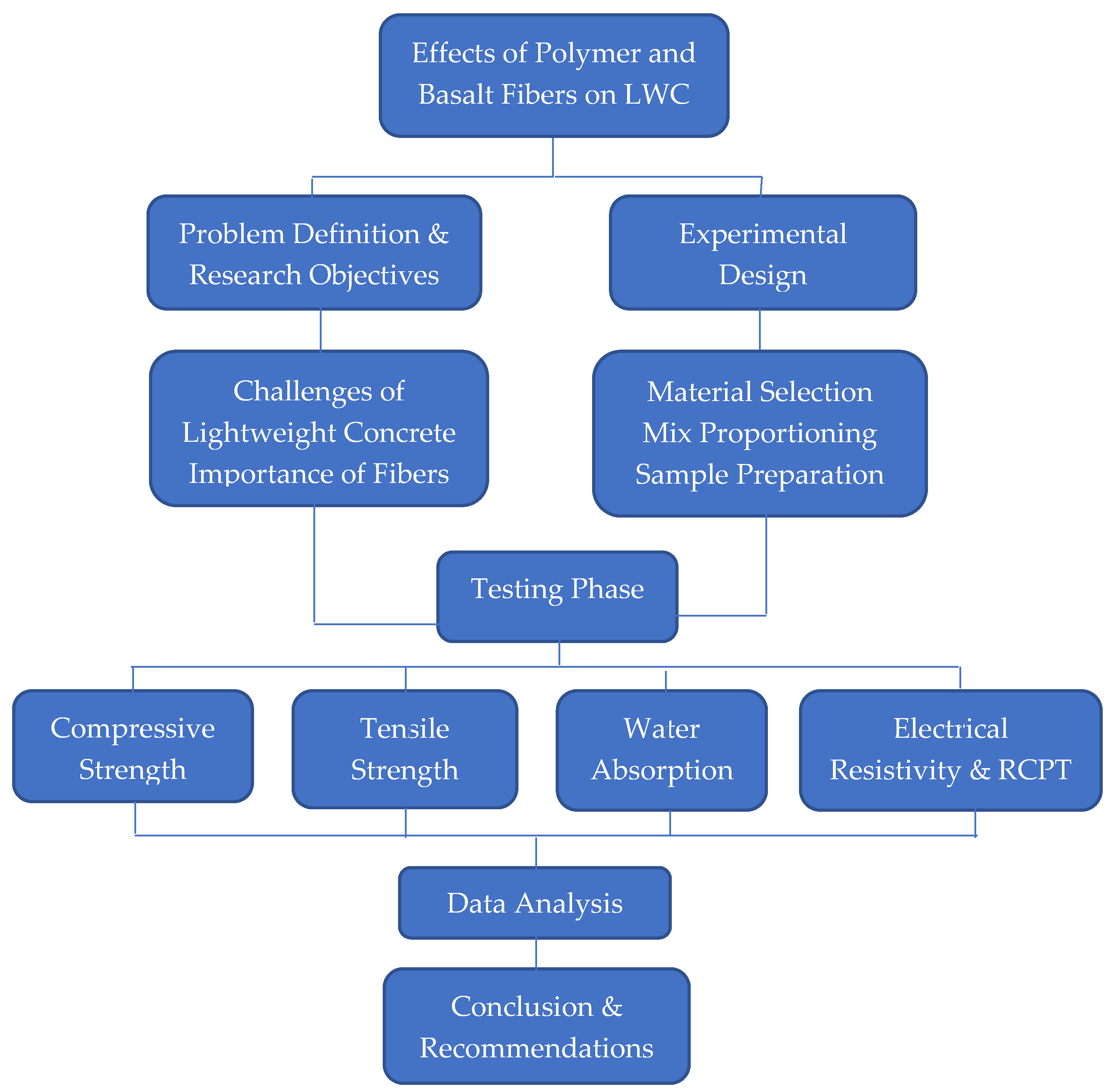
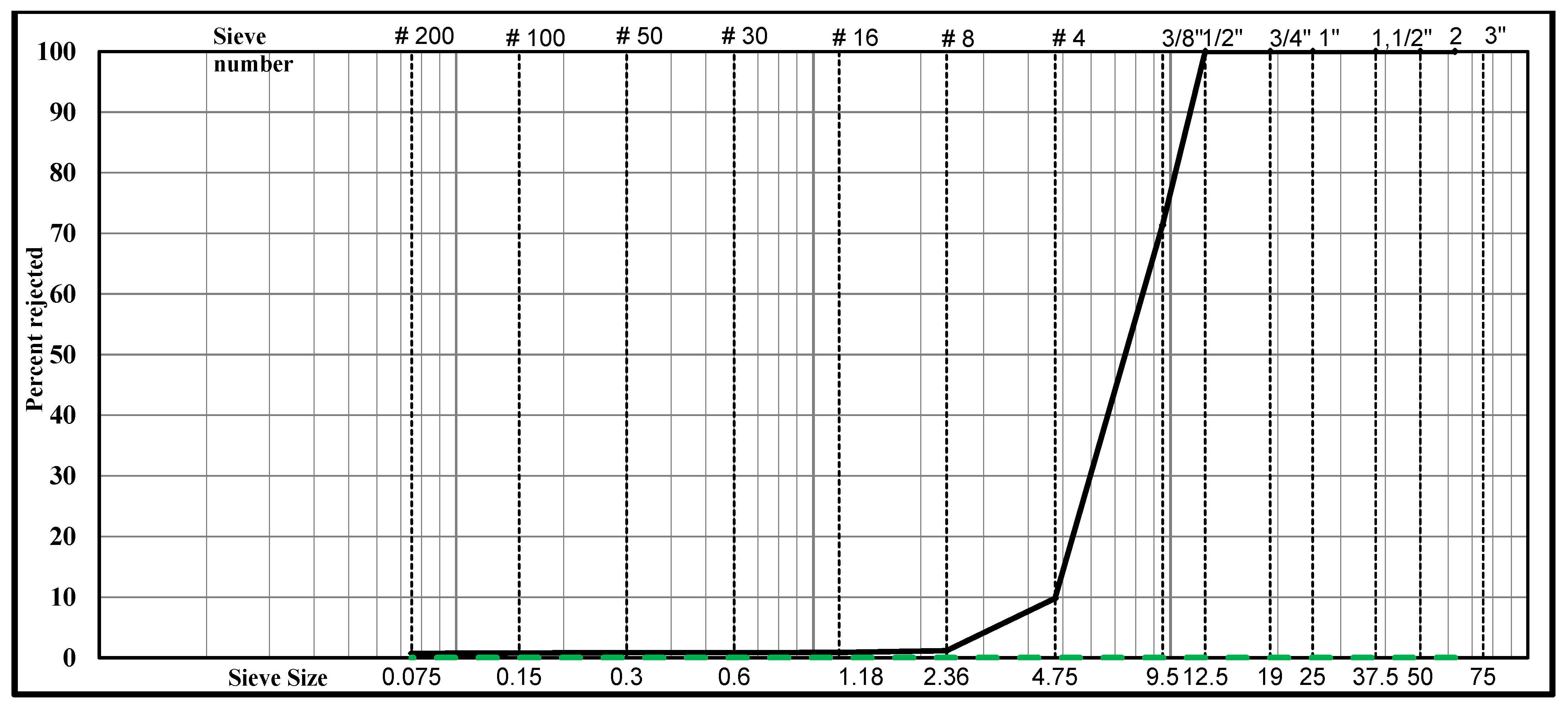
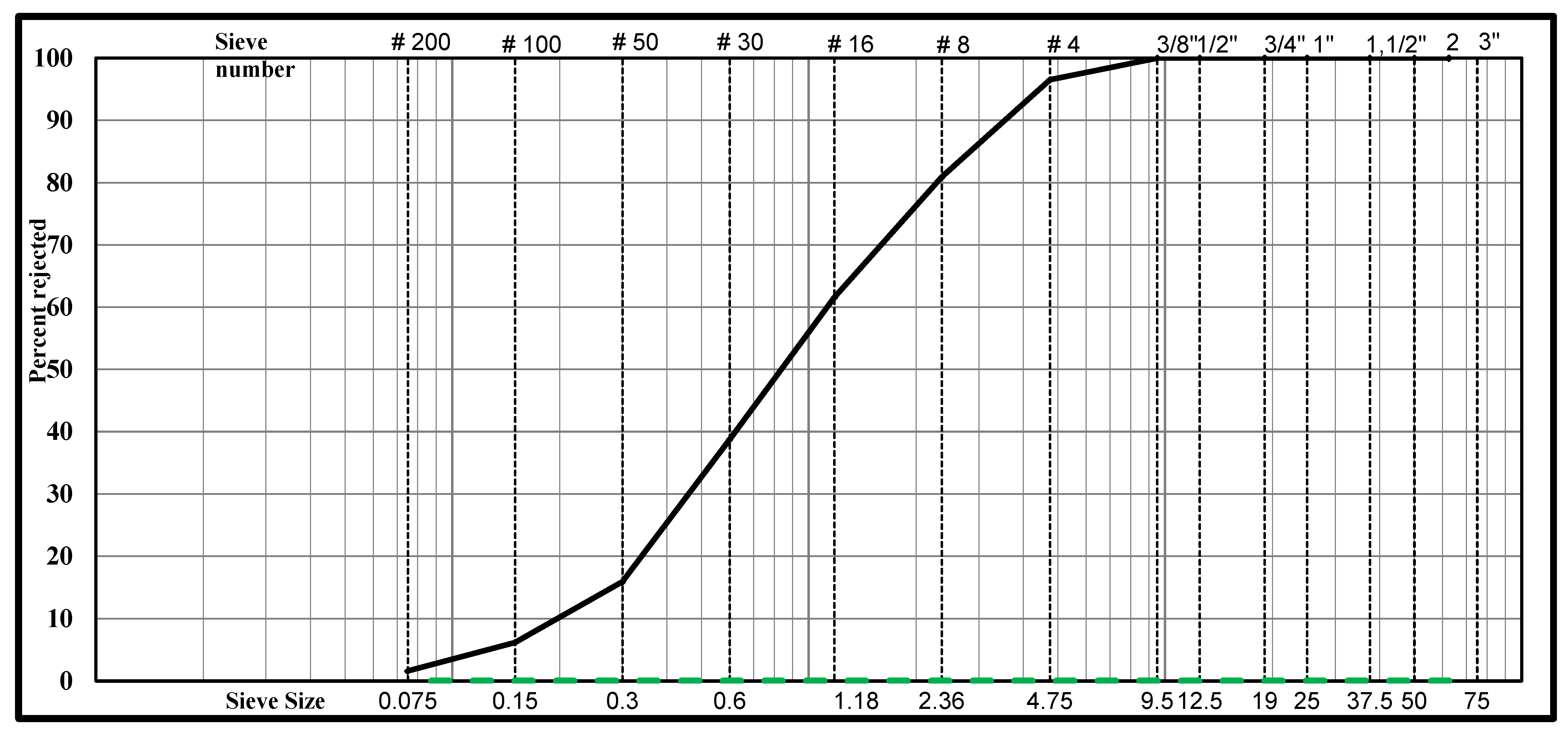


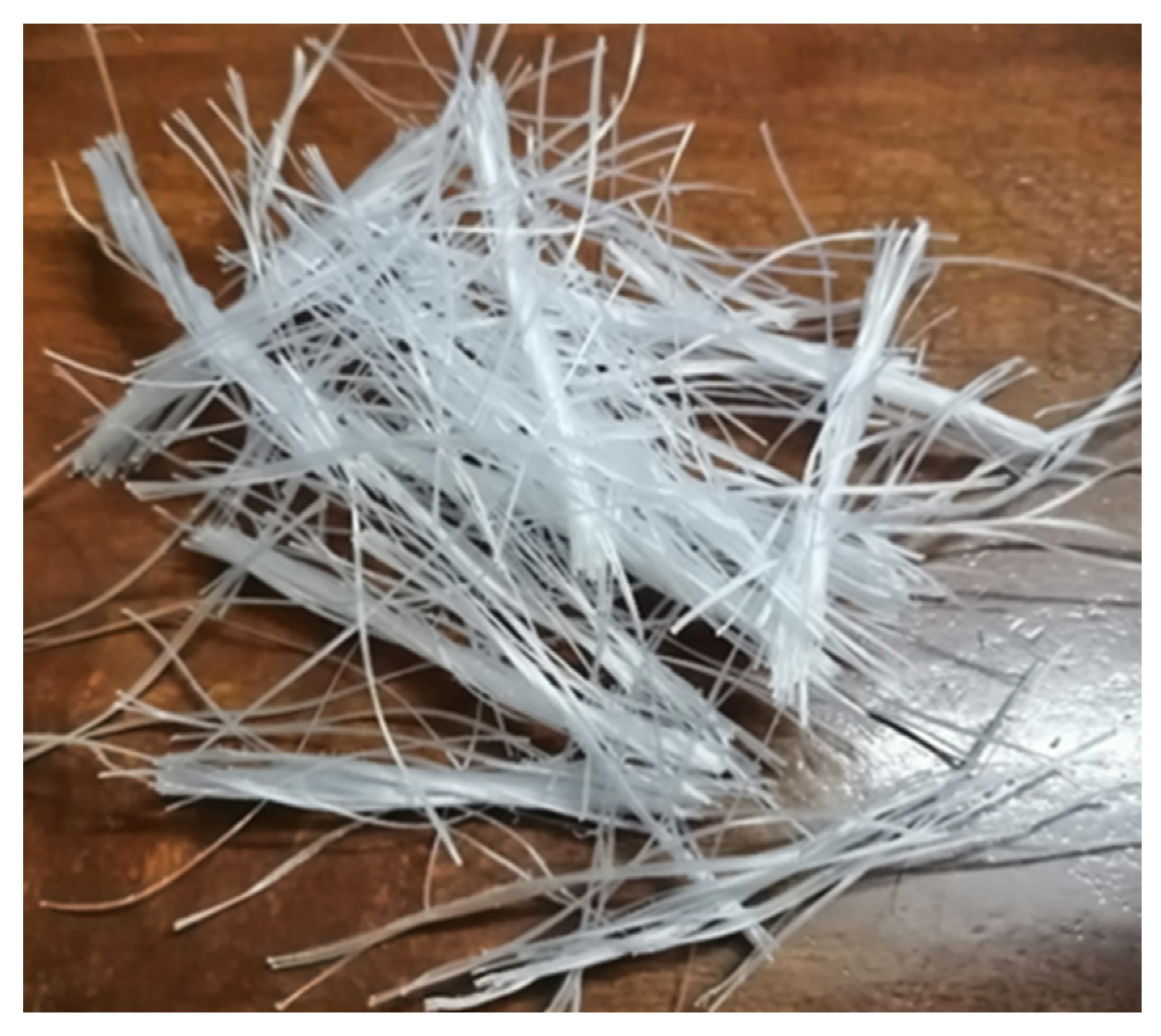

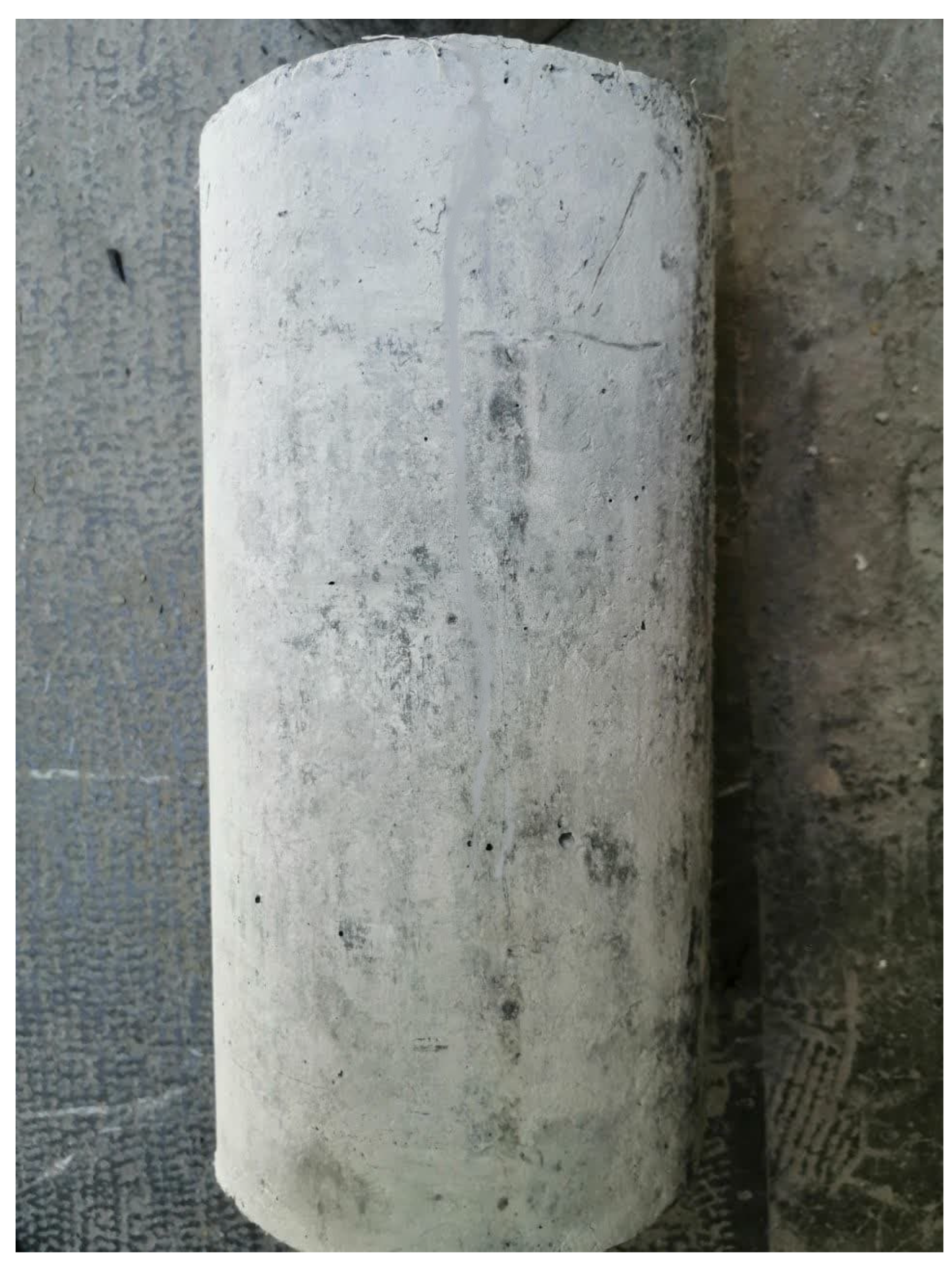

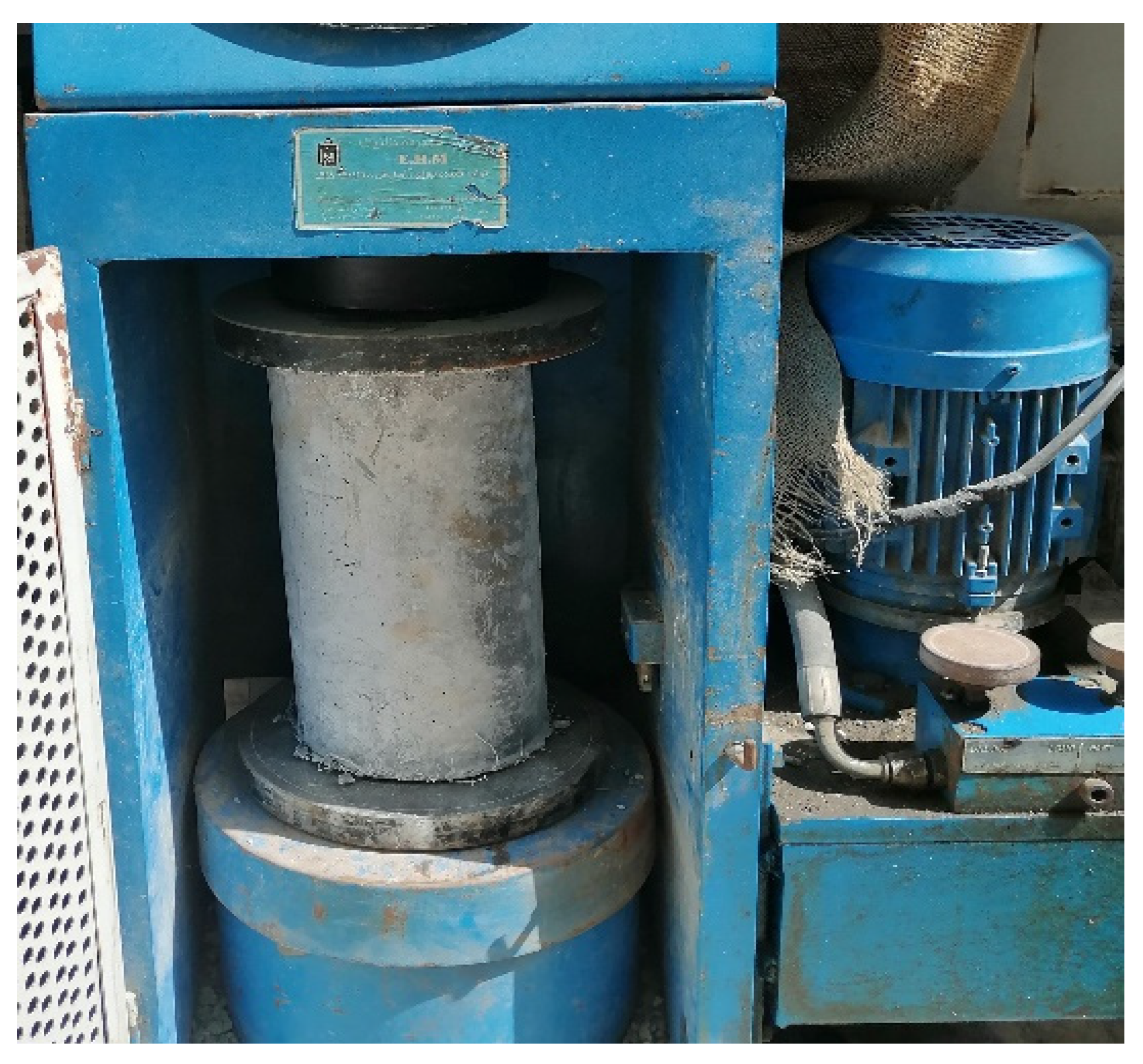
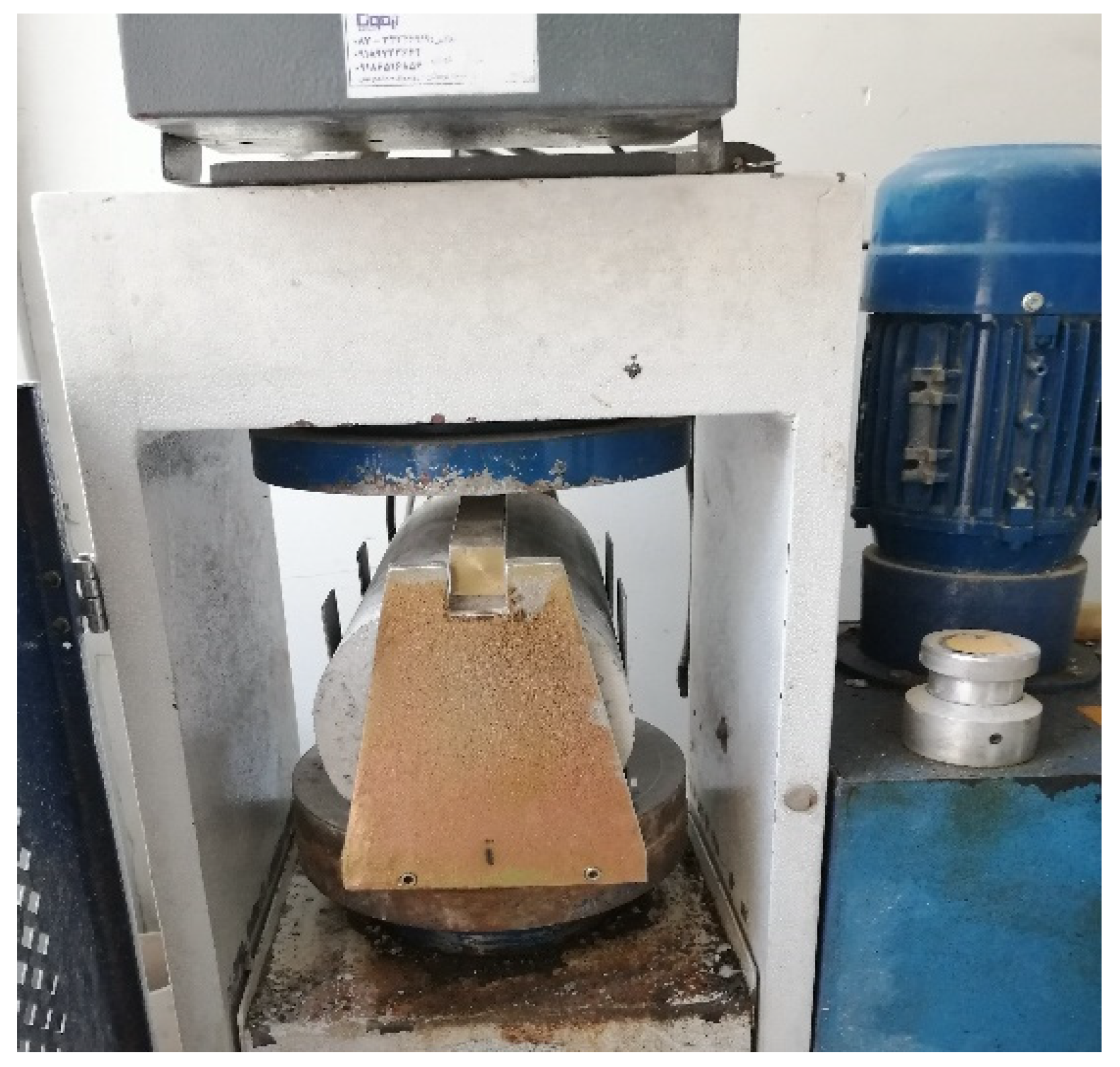
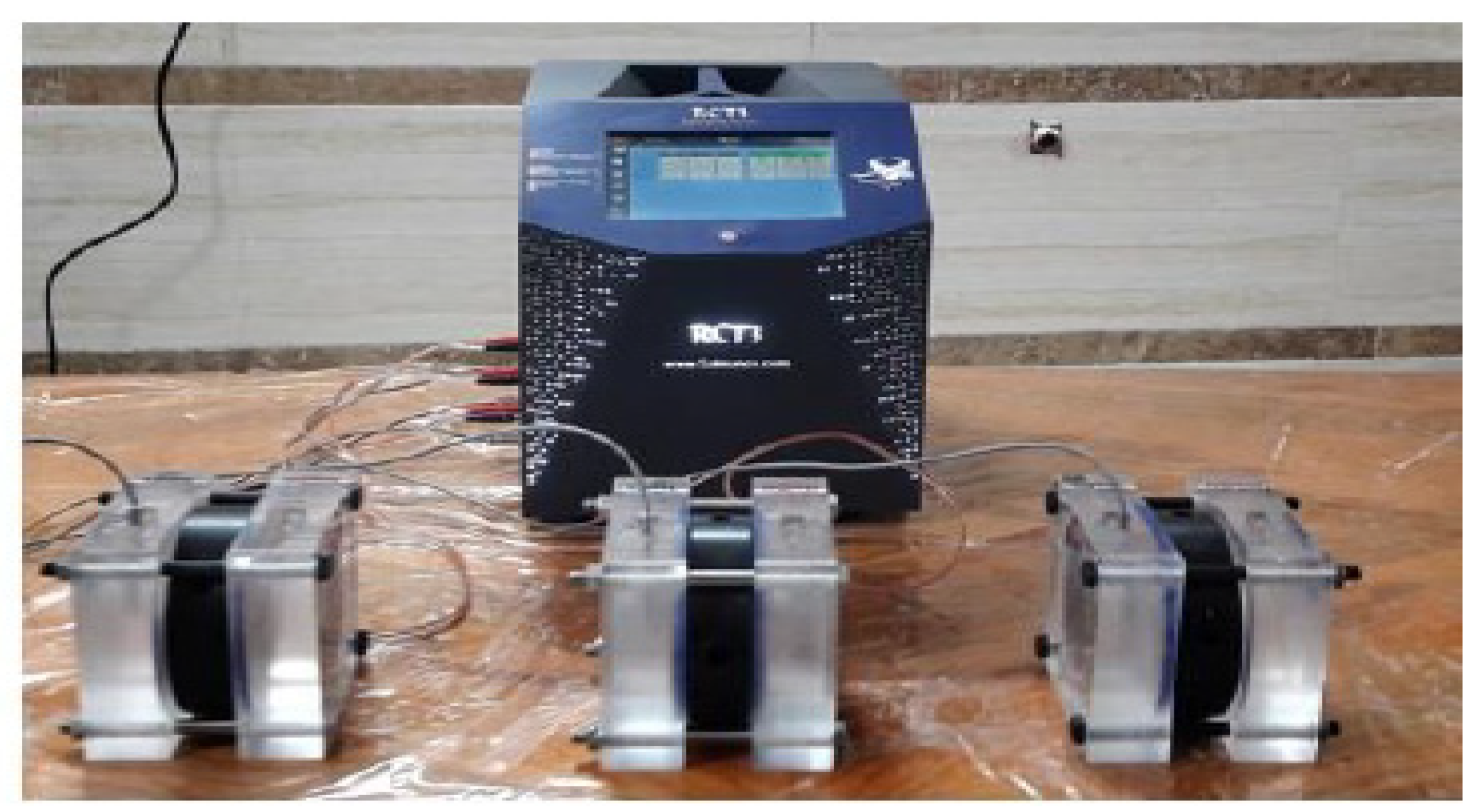

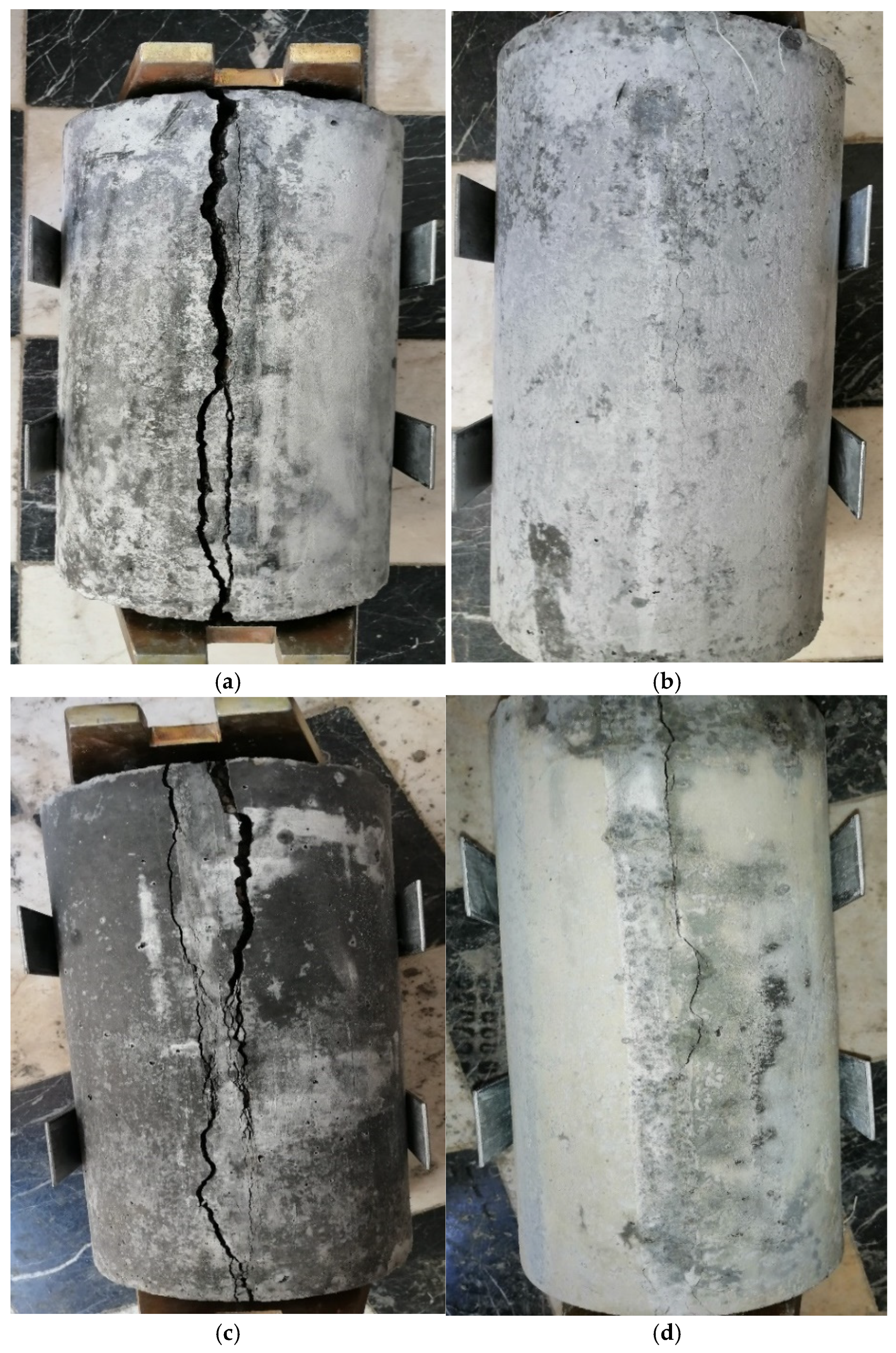

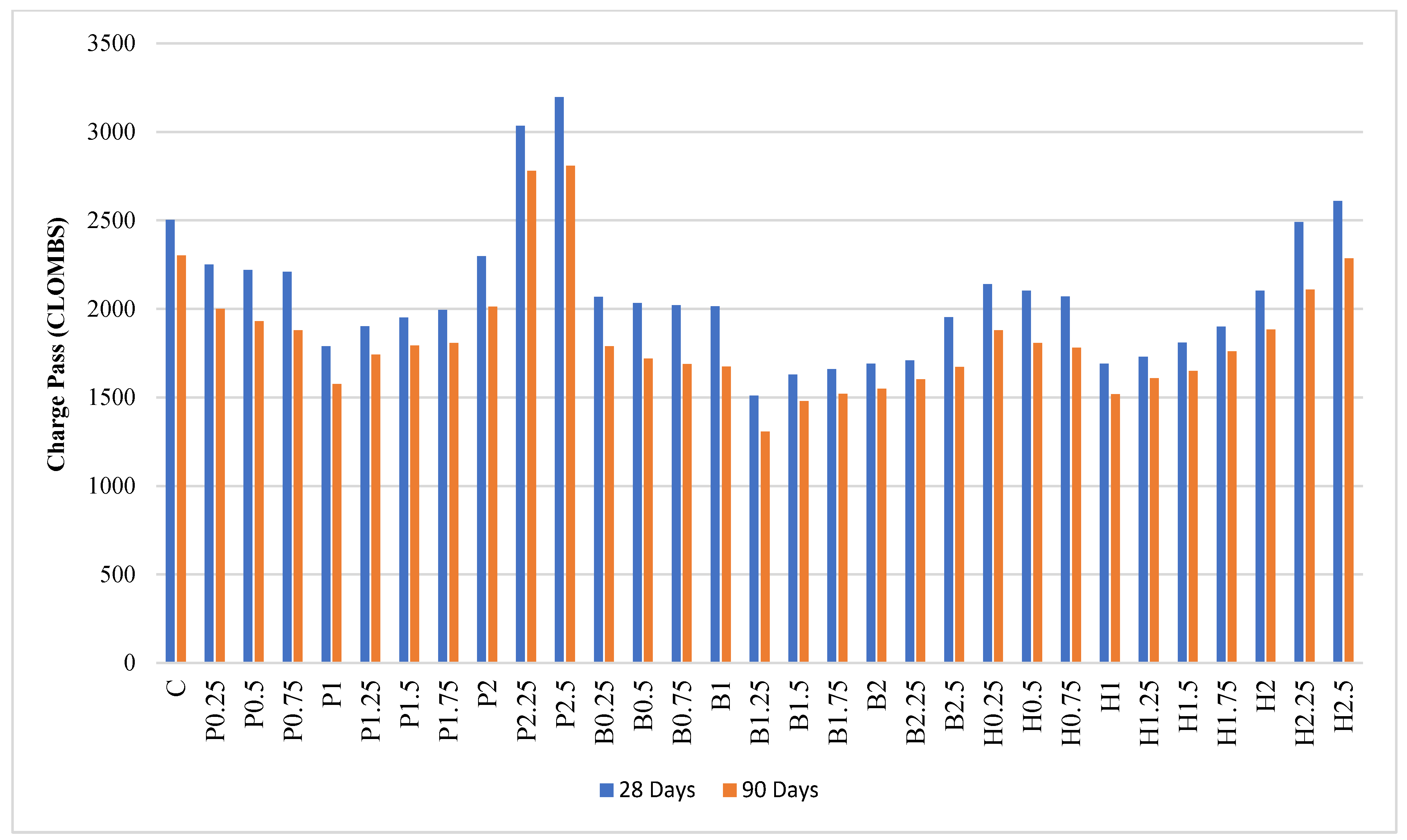
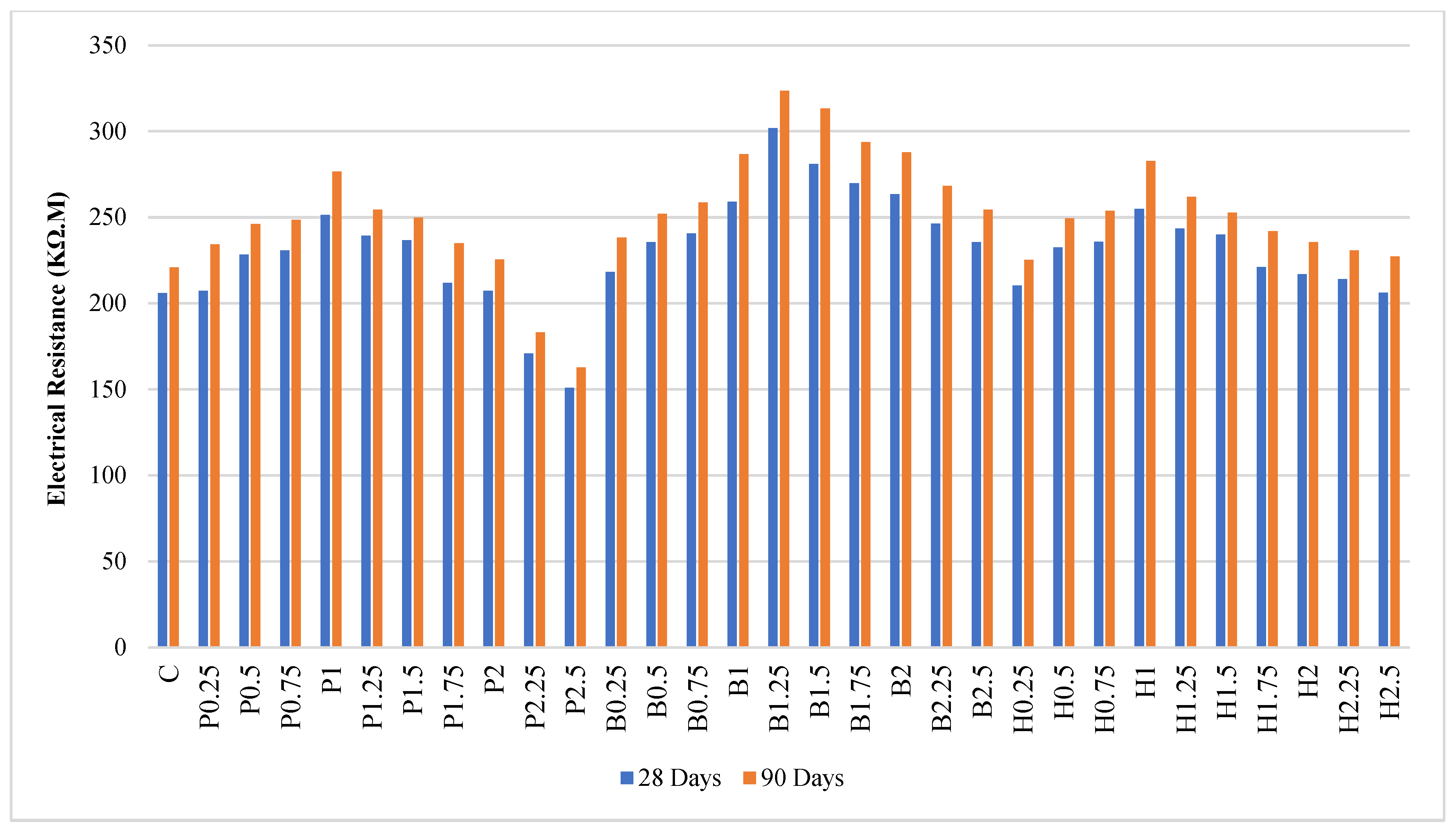
| Chemical Specification | Cement (%) | Micro-Silica (%) |
|---|---|---|
| SiO2 | 20.7 ± 0.3 | 90–95 |
| CaO | 65 ± 0.5 | 0.5–1 |
| Al2O3 | 5.2 ± 0.2 | 0.6–1.2 |
| Fe2O3 | 4.6 ± 0.2 | 1.2–1.8 |
| Na2O | 0.15 ± 0.2 | - |
| MgO | 1.8 ± 0.2 | 0.6–1.2 |
| So3 | 2.2 ± 0.4 | - |
| K2O | 0.5 ± 0.05 | - |
| C | - | 0.8–2 |
| Cl | - | 0.05–0.07 |
| C3S | 59.47 | - |
| C2S | 14.48 | - |
| C3A | 6 | - |
| C4AF | 14 | - |
| Free CaO | 1.3 ± 0.2 | - |
| Properties | Coarse Aggregates (Gravel) | Fine Aggregates (Sand) | Leca |
|---|---|---|---|
| Size (mm) | 6–12 | 0–4.75 | 4–10 |
| Bulk Density (kg/m3) | 2720 | 2713 | 370 |
| Dry Density (kg/m3) | 2659 | 2585 | 320 |
| Fineness Modulus | 6.14 | 3.00 | - |
| Water Absorption (%) | 0.79 | 1.83 | 18 |
| FM | 6.14 | 3.00 | - |
| SE (%) | - | 79 | - |
| Fiber | Length (mm) | Diameter (µm) | Aspect Ratio (L/D) | Tensile Strength (MPa) | Elastic Modulus (MPa) | Water Absorption (%) | Density (kg/m3) |
|---|---|---|---|---|---|---|---|
| Polymer Wave (PF) | 55 | 200 | 275 | 450–700 | 3500–7000 | 0 | 910 |
| Basalt (BF) | 12 | 18.5 | 64.86 | 2800–3200 | 82,000–92,000 | 8–10 | 2800 |
Disclaimer/Publisher’s Note: The statements, opinions and data contained in all publications are solely those of the individual author(s) and contributor(s) and not of MDPI and/or the editor(s). MDPI and/or the editor(s) disclaim responsibility for any injury to people or property resulting from any ideas, methods, instructions or products referred to in the content. |
© 2025 by the authors. Licensee MDPI, Basel, Switzerland. This article is an open access article distributed under the terms and conditions of the Creative Commons Attribution (CC BY) license (https://creativecommons.org/licenses/by/4.0/).
Share and Cite
Maleki, P.; Shadabfar, M.; Kordestani, H. An Experimental Investigation of the Effects of Adding Polymer and Basalt Fibers on the Mechanical Properties and Durability of Lightweight Concrete. Buildings 2025, 15, 911. https://doi.org/10.3390/buildings15060911
Maleki P, Shadabfar M, Kordestani H. An Experimental Investigation of the Effects of Adding Polymer and Basalt Fibers on the Mechanical Properties and Durability of Lightweight Concrete. Buildings. 2025; 15(6):911. https://doi.org/10.3390/buildings15060911
Chicago/Turabian StyleMaleki, Peyman, Mahdi Shadabfar, and Hadi Kordestani. 2025. "An Experimental Investigation of the Effects of Adding Polymer and Basalt Fibers on the Mechanical Properties and Durability of Lightweight Concrete" Buildings 15, no. 6: 911. https://doi.org/10.3390/buildings15060911
APA StyleMaleki, P., Shadabfar, M., & Kordestani, H. (2025). An Experimental Investigation of the Effects of Adding Polymer and Basalt Fibers on the Mechanical Properties and Durability of Lightweight Concrete. Buildings, 15(6), 911. https://doi.org/10.3390/buildings15060911








